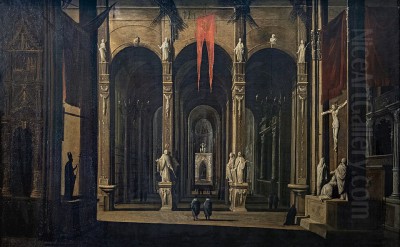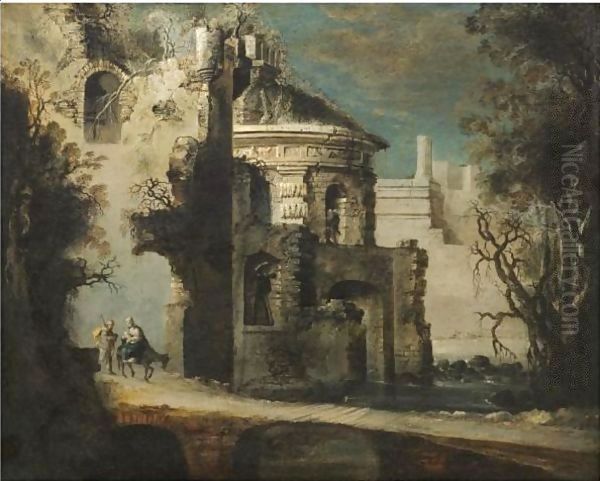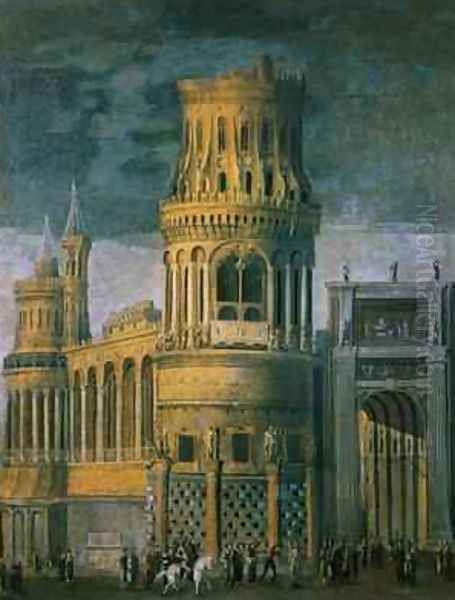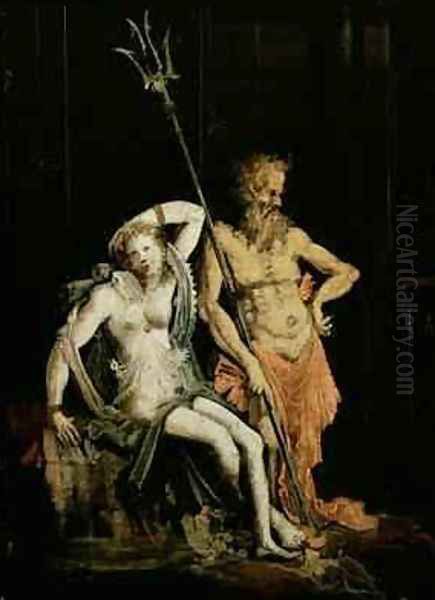
François de Nomé stands as one of the most intriguing and enigmatic figures of the early Baroque period. A painter of French origin who spent his productive years in Italy, Nomé crafted a unique visual language characterized by phantasmagorical architecture, crumbling ruins, and dramatic, often catastrophic, scenes drawn from biblical narratives, mythology, or pure imagination. For centuries, his identity was obscured, his works conflated with those of his compatriot Didier Barra under the mysterious moniker "Monsù Desiderio." However, modern scholarship has resurrected Nomé from anonymity, revealing an artist whose bizarre and captivating visions anticipated aspects of Surrealism centuries later.
From Lorraine to Rome: Early Life and Formation
Evidence points to François de Nomé being born around 1593 in Metz, a city in the Duchy of Lorraine, a region with its own distinct artistic identity, bridging French, German, and Netherlandish influences. Like other artists from Lorraine, such as the celebrated printmaker Jacques Callot and the master of nocturnal light Georges de La Tour, Nomé sought opportunities beyond his homeland. His artistic journey began in earnest when he moved to Italy as a youth, drawn to the vibrant artistic center of Rome.
In Rome, during the first decade of the 17th century, Nomé is documented as having studied under Balthasar Lauwers (also known as Baltheus Laureus or Lauro). Lauwers was a Flemish landscape painter active in Rome, known for his detailed depictions often incorporating classical ruins, a theme that would resonate profoundly, albeit transformed, in Nomé's later work. Rome at this time was a melting pot of artistic innovation, still reeling from the revolutionary naturalism of Caravaggio and witnessing the rise of classical landscape painting pioneered by artists like Annibale Carracci and Paul Bril. Nomé absorbed these currents, yet his path would diverge significantly from the mainstream.

Some art historians suggest potential contact or influence during his Roman period from Northern artists specializing in architectural views or fantastical scenes, perhaps figures like Jacob van Swanenburgh, who was known for his depictions of hell and imaginary architecture and was active in Italy, including Naples, around the time Nomé was developing his skills. While direct links are speculative, the intricate detail found in some Northern architectural painting traditions, exemplified earlier by artists like Hans Vredeman de Vries, might form part of the complex background to Nomé's later style.
Naples: The Crucible of a Unique Style
Around 1610, François de Nomé relocated to Naples, the bustling, chaotic, and artistically fertile Spanish viceroyalty in Southern Italy. It was here that he would spend the remainder of his career, developing the highly personal and often unsettling style for which he is known. Naples provided a dramatic backdrop – a city marked by vibrant street life, intense religious fervor, seismic activity, and the looming presence of Mount Vesuvius. This environment may have contributed to the themes of destruction and ephemeral grandeur that permeate his work.
In Naples, Nomé found a compatriot and collaborator in Didier Barra, also originally from Metz. Barra specialized primarily in topographical views (vedute) of Naples, often depicting recognizable landmarks and cityscapes with meticulous detail. The two artists are known to have shared living quarters and occasionally collaborated on paintings. This collaboration, however, led to centuries of confusion regarding their individual contributions.
Nomé established himself in Naples, marrying Isabella Croys, the daughter of Flemish painter and art dealer Loise Croys, in 1613. He seems to have found a niche market for his unusual paintings, which stood apart from the dominant trends in Neapolitan art, then heavily influenced by the dramatic realism of Jusepe de Ribera and the burgeoning Neapolitan Baroque school featuring artists like Massimo Stanzione and later, Bernardo Cavallino and Artemisia Gentileschi (who was active in Naples during part of Nomé's career).
The Enigma of Monsù Desiderio
For much of art history, the distinct artistic personalities of François de Nomé and Didier Barra were subsumed under the single, enigmatic name "Monsù Desiderio." "Monsù" was a common Neapolitan corruption of the French "Monsieur," used to refer to foreign artists, particularly those from France or the Low Countries. The surname "Desiderio" might have been a nickname or a misunderstanding, its origins remaining obscure.

Works signed or attributed to "Monsù Desiderio" displayed a curious mix of styles: precise topographical cityscapes often coexisted with wildly imaginative, crumbling architectural fantasies within the same corpus, and sometimes even within the same painting. This stylistic dichotomy puzzled scholars for generations. It wasn't until the mid-20th century, through careful stylistic analysis and the discovery of documentary evidence, that art historians began to disentangle the contributions of the two artists.
It is now generally accepted that Didier Barra was primarily responsible for the more realistic city views and landscapes, often characterized by a cooler palette and precise rendering. François de Nomé, conversely, is credited with the fantastical architectural inventions, the dramatic ruin scenes, the biblical and mythological narratives set in bizarre, often collapsing structures, and the hellish visions. His style is typically warmer in tone, more painterly, and imbued with a sense of theatricality and unease. Some works are clear collaborations, while others are attributed solely to one or the other, though debate continues over certain pieces. The "Monsù Desiderio" label likely represented a workshop or a convenient brand for these French artists working in Naples.
Artistic Vision: Themes and Style
François de Nomé's oeuvre is dominated by architectural subjects, but these are rarely straightforward depictions. He specialized in capricci – architectural fantasies – often featuring impossible juxtapositions of classical, Gothic, and imaginary structures. Towers lean precariously, colonnades twist into irrational perspectives, and vast edifices seem on the verge of imminent collapse. Ruins are a recurring motif, depicted not with romantic nostalgia, but often with a sense of violent destruction or eerie decay.
Biblical and mythological narratives provided Nomé with frameworks for his architectural inventions. Scenes like The Flight into Egypt or The Martyrdom of a Saint are staged within elaborate, often crumbling, architectural settings that dwarf the human figures. These settings are not mere backdrops; they are active participants in the drama, their instability and grandeur reflecting the intensity of the depicted events. His depictions of Hell are particularly striking, filled with tormented figures amidst fiery, cavernous, and bizarrely constructed infernal landscapes.

Nomé's style is characterized by dramatic, often plunging perspectives and exaggerated scale, creating a sense of disorientation and awe. He employed strong contrasts of light and shadow (chiaroscuro), though often in a theatrical, unnatural way, illuminating scenes with an otherworldly glow or the lurid light of explosions and fires. His brushwork could range from meticulous detail in rendering architectural ornamentation to looser, more expressive handling in depicting smoke, fire, or chaotic crowds. His color palettes often feature warm earth tones, fiery reds and oranges, contrasted with deep shadows and sometimes unsettling blues and greens.
The overall effect of Nomé's work is one of profound strangeness. His paintings possess a dreamlike, hallucinatory quality that seems out of step with the prevailing naturalism or classicism of his time. The meticulous rendering of impossible scenes creates a cognitive dissonance, a sense of witnessing something both real and utterly fantastic. It is this quality that led 20th-century Surrealists to recognize him as a spiritual precursor.
Key Works and Analysis
Several works exemplify François de Nomé's unique vision. His depictions of The Flight into Egypt, a common theme, are transformed into unsettling journeys through vast, decaying architectural landscapes, the Holy Family dwarfed by the scale and strangeness of their surroundings. The architecture seems less a refuge than a symbol of a crumbling world.
Paintings titled Hell or depicting infernal scenes showcase Nomé's unrestrained imagination. These are often chaotic compositions filled with tiny, writhing figures enduring torment amidst fantastical, fiery structures that defy gravity and logic. They combine the horror of the subject with a bizarre architectural inventiveness.
The Circumcision of Christ might be set within an impossibly vast temple, its soaring arches and complex spaces rendered with a dizzying perspective that emphasizes the ritual's solemnity while also creating a sense of unease. Similarly, Virgin and Child with Saint Bruno places the serene figures within an elaborate, perhaps partially ruined, architectural niche, blending devotional intimacy with architectural fantasy.
Other typical subjects include scenes of martyrdom, plagues, or explosions within churches or cities. Explosion in a Church, for instance, captures a moment of catastrophic violence, the force of the blast ripping through the sacred space, rendered with dramatic lighting and flying debris. His architectural capricci, devoid of specific narratives, focus purely on the evocative power of imaginary ruins and fantastical structures, often bathed in an eerie moonlight or sunset glow. These works highlight his fascination with the decay of grandeur and the power of the imagination to construct and deconstruct worlds.
Contemporaries and Connections
While Nomé's style remained highly individual, he operated within a complex artistic network. His training under Balthasar Lauwers in Rome provided a foundation in landscape and perhaps detailed rendering. His close association and collaboration with Didier Barra in Naples was central to his career and the subsequent "Monsù Desiderio" confusion.
Although stylistically distinct, Nomé shared the Lorraine origins of Jacques Callot, whose intricate prints often depicted crowds, battles, and fantastical scenes, suggesting a shared regional interest in detailed, imaginative compositions. He also worked in Naples during the time of major figures like Jusepe de Ribera, whose gritty realism and dramatic tenebrism dominated the local school, providing a stark contrast to Nomé's fantastical leanings. The presence of Artemisia Gentileschi, Massimo Stanzione, and Bernardo Cavallino further underscores the rich artistic milieu in which Nomé carved out his unique niche.
While Nomé did not significantly influence the mainstream of Italian landscape or architectural painting, his work resonates with certain aspects of later artists. The dramatic, often wild landscapes and ruin capricci of Salvatore Rosa, another prominent Neapolitan painter (though younger), share a certain romantic intensity, even if Rosa's style is broader and more focused on nature's untamed power. Similarly, the bamboccianti painters active in Rome, like Michelangelo Cerquozzi, sometimes incorporated ruins into their scenes of everyday life, though with a focus different from Nomé's fantastical visions.
The most remarkable connection, however, bridges the centuries. Nomé's irrational perspectives, dreamlike atmospheres, and juxtaposition of the mundane and the bizarre struck a chord with Surrealist artists in the 20th century. Salvador Dalí and Giorgio de Chirico, pioneers of Surrealism and Metaphysical Painting respectively, saw in Nomé's work an early manifestation of the subconscious anxieties and fantastical visions they sought to explore. De Chirico's empty, arcaded piazzas and Dalí's melting clocks and dream landscapes share a spiritual kinship with Nomé's eerie architectural realms.
Rediscovery and Legacy
After his death, likely sometime around 1644, François de Nomé faded into obscurity, his work largely forgotten or misattributed to the composite figure of "Monsù Desiderio." The unique nature of his art, lying outside the main currents of Baroque painting, contributed to this neglect.
Interest in "Monsù Desiderio" began to revive in the early 20th century, particularly among collectors and scholars intrigued by the bizarre and imaginative quality of the paintings attributed to this name. The Surrealists' fascination in the 1930s provided a significant boost, reframing these strange Baroque works not as mere curiosities, but as precursors to modern artistic explorations of the psyche and the irrational.
The subsequent scholarly work distinguishing Nomé from Barra allowed for a clearer appreciation of François de Nomé's specific contribution. Exhibitions dedicated to "Monsù Desiderio" and, more recently, focusing on Nomé himself, have brought his work to a wider audience. Today, his paintings are held in major museums worldwide, including the National Gallery in London, the Fitzwilliam Museum in Cambridge, and the John and Mable Ringling Museum of Art in Sarasota.
François de Nomé's legacy lies in his uncompromisingly personal vision. He was an artist who used the vocabulary of Baroque drama and architectural painting to create worlds entirely his own – worlds of unsettling beauty, catastrophic grandeur, and profound mystery. He stands as a testament to the unpredictable paths of artistic imagination, an architect of dreams and desolation whose enigmatic works continue to fascinate and disturb centuries after their creation. His unique blend of meticulous detail and fantastical conception secures his place as a singular, if solitary, master of the Baroque era.